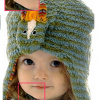Free Online Productivity Tools
i2Speak
i2Symbol
i2OCR
iTex2Img
iWeb2Print
iWeb2Shot
i2Type
iPdf2Split
iPdf2Merge
i2Bopomofo
i2Arabic
i2Style
i2Image
i2PDF
iLatex2Rtf
Sci2ools
100
click to vote
CVPR
2010
IEEE
2010
IEEE
Context-Constrained Hallucination for Image Super-Resolution
This paper proposes a context-constrained hallucination approach for image super-resolution. Through building a training set of high-resolution/low-resolution image segment pairs, the high-resolution pixel is hallucinated from its texturally similar segments which are retrieved from the training set by texture similarity. Given the discrete hallucinated examples, a continuous energy function is designed to enforce the fidelity of high-resolution image to low-resolution input and the constraints imposed by the hallucinated examples and the edge smoothness prior. The reconstructed high-resolution image is sharp with minimal artifacts both along the edges and in the textural regions.
Computer Vision | Context-constrained Hallucination Approach | CVPR 2010 | Discrete Hallucinated Examples | Training Set |
Related Content
| Added | 13 Apr 2010 |
| Updated | 14 May 2010 |
| Type | Conference |
| Year | 2010 |
| Where | CVPR |
| Authors | Jian Sun, Jiejie Zhu, Marshall Tappen |
Comments (0)

